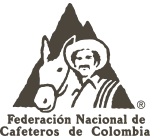



At the end of the COFFEE PICKINN challenge, the FNC (National Coffee Growers Federation) thanks and congratulates all exponents for their participation.
It is gratifying to see the enthusiasm and interest to solve the challenge in the academic and business community; especially the commitment to provide solutions for Colombian coffee growers.
In order to objectively evaluate the different proposals, the FNC formed a multidisciplinary Committee of experts, who selected 11 proposals to advance to the interview round, where solvers presented their initiatives to a panel of FNC directors. At the end of this round, the Committee selected 3 proposals which demonstrated the greatest potential for scale-up and affinity with the challenge in the specific conditions of coffee growing. With the 3 selected proposals, a phase of testing, adaptation and development will begin to allow their future implementation in the Colombian market. These are the ones:
- Assisted robotic coffee harvesting unit RAMON "presented by the German Fraunhofer Institute IPK.
- Electromechanical fruit harvester with power regulator "presented by Campagnola Iberica.
- Specialized clothing, coffee collector 6000 "presented by the independent coffee grower Ricardo Gómez Posada.
The FNC especially highlights the participation of the Universidad Antonio Nariño de Colombia, and the talent demonstrated by its students of Industrial Design and Mechanical Engineering, who in a short time put great effort in the configuration of novel ideas, of which 4 were evaluated in the round of interviews. Likewise, the participation and cleverness of independent proponents Julián Eduardo is highlighted with his proposal "Mechanism of parallel coffee harvesting" and Santiago Hernández with his proposal "Fast fingers".
To the other proponents that were not prioritized, the FNC appreciates their time and effort dedicated to their participation in this call, and encourages them to continue with their process of iteration and development, we are sure that there are great ideas that can become real solutions for Colombian coffee growing.
Dec 18/2017.
THE CHALLENGE
HOW TO MAKE COFFEE HARVESTING MORE EFFICIENT IN COLOMBIA?
The Colombian Coffee Growers Federation (Federation) is looking for innovative proposals coming from entrepreneurs, research groups and/or companies offering a solution that would make the process of selective coffee harvesting in Colombia more efficient.
The solutions with the greatest potential for tackle the challenge, will be sponsored by the Federation through economic contributions and/or in kind, to be developed and subsequently implemented in the Colombian countryside. The Federation is willing to develop a strategic alliance with the challenge solver(s) that leads to the implementation of the following stages, according to the degree of progress of the proposed solution:
• Develop the chosen solution through its own funds or obtain them through third parties;
• Advance the experimental process, adjustment and final development of the solution through mentors and partners;
• Enable ownership of the solution by potential users through training and awareness processes .
Depending on the state of progress of solutions, different approaches for a rapport scheme between the Federation and those proposing the solution can be set forth:
• Co-financing of seed capital: support for the creation and strengthening of a business enterprise;
• Provision of services: guaranteed contract for a certain amount of time for the selected enterprise to develop and implement the solution;
• Business partners: shared risks and investments in a prospective business aimed at designing and marketing the solution.
CONTEXT
Coffee is one of the great icons of Colombian culture. From the latter half of the 19th century, coffee growing has been one of the main drivers of the national economy, not only because of its high currency generating capacity - which has assisted local and regional development – but also because it has enabled the internationalization of the country. It has also provided Colombia with global context recognition in as far as quality of the beans and the institutional strength of its trade association, represented by the Colombian Coffee Growers Federation, founded over 90 years ago.
Coffee growing represents around 23% of the agricultural GDP in Colombia, and over 7% of overall exports. It embodies the greatest source of rural employment, generating around 730,000 direct jobs, equal to 25% of agricultural sector jobs. Colombian coffee is always appreciated due its high quality and the symbols of Colombian coffee growing - Juan Valdez and the brand Café de Colombia, which are globally recognized icons.
The distinctive quality of a cup of Colombian coffee is defined by different aspects, but mainly by its taste and aroma. What is the secret? The secret is a process of selective manual harvesting whereby only ripe beans are harvested, and together with the agro-ecologic characteristics intrinsic to the Colombian mountains, it provides unique attributes to our coffee.
However, this process has made manual labor – which picks the coffee in a selective manner – more andincreasingly more scarcescarce in the rural areas, at the same time making the harvesting labor costs rise to around 50% of the total production costs; putting the crop profit at risk.
There are different alternatives and solutions around the world for other crops (olives in Spain) and even for coffee grown in different agricultural production systems (Brazil). However, conditions for coffee growing in Colombia (described in the text) have shown to be particular, which makes adaptation of solutions developed in other countries unfeasible in here.
The Federation is seeking for innovative solutions that will make the harvesting process in Colombia more efficient in order to further boost this country’s iconic product and to bring sustainability and profitability to more than 560.000 families whose livelihood is the production of this bean. Proposals should keep in mind aspects such as how innovative the proposal is, how easy it would be for coffee pickers to develop ownership of the process, and the cost-benefit relation for the producers who are to implement the innovation.
DESCRIPTION
In search of compliance with its mission objective - to pursue the wellbeing of the coffee growing families – the Federation has identified an escalating issue in the harvesting process, linked to the high labor costs and the scarcity of manual labor that curtail profitability and competitiveness in coffee growing sector. Upon examining the possible causes of the problem, it became evident that in order Tto achieve higher efficiency in coffee harvesting isit was necessary to address four aspects that are interrelated:
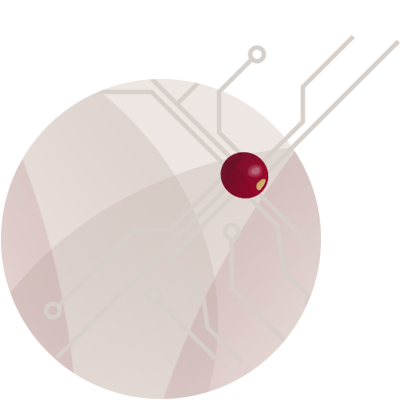
Technological factor:
The coffee harvesting process is characterized for being a manual process that enables an assurance of utmost care for the tree and the fruit, which has an impact on the quality of the beans harvested. There have been attempts at improving the harvesting process, including solutions that range from assisted manual harvesting to a more automated process. However, some of these solutions remain at the prototype stage and are not appropriate as per the coffee pickers. Other solutions have a high impact on the crop and can deteriorate the vegetal structure of the tree (affecting the following harvests) or even become a multiplying factor for the coffee borer, given the high percentage of beans left on the ground.
The purpose, from a technological point of view, is to find a solution that is highly efficient (low cost and high performance – quantity of beans picked per hour) with high quality and efficiency (high percentage of ripe fruit in the volume harvested and low number of fallen fruit).
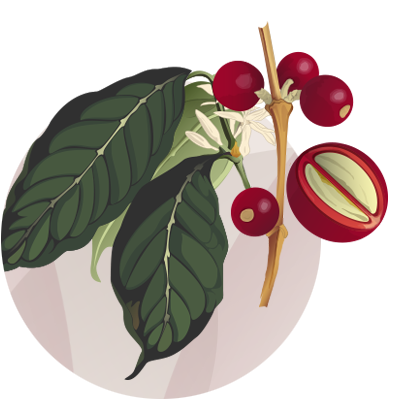
Agronomic factor:
In Colombia, most coffee farming is found between 1° - 11° LN and between 1,200 and 1,800 m above sea level, given that the average temperatures range between 17 and 23 degrees Celsius, and precipitation is close to 2,000 millimeters per year, scattered throughout the year. These characteristics determine the specific conditions of sunshine, water availability, relative humidity and temperature to grow this crop; these conditions affect the volume and concentration of the crop. This allows for a single tree to offer fruit at different stages of development, ranging from green berries to ripe and overripe berries.
This implies that It's common for the pickers to pass though several times to pick all of the ripe cherries, given that if late harvesting is done, the berries will be overripe and can fall to the ground, exacerbating the coffee borer attacks. On the other hand, if the harvesting is done too early, some fruit can be unripe and this affects the quality, and hence the price of the harvest. This is the reason why manual picking, berry by berry, has been to this day, the best method to ensure that most of the berries are picked at their optimum stage of maturity.
Dry spells with some rain are more favorable for the concentration of the harvest (even in very dry periods, such as in the occurrence of El Niño phenomenon) since the plant requires a period of hydrological stress for its reproduction process. By contrast, the periods with higher rain incidence, or intermittence (including periods in the occurrence of la Niña) tend to generate more disperse blooming that affects concentration of the harvest. This is the reason why climatic variability is a factor to be considered independently of the variety grown - even though the crops grown in varieties susceptible to the coffee borer require extra care due to the affectation that the fungus generates on the foliage cover.
The topography of the coffee growing areas in Colombia also has repercussions in the harvesting process, making it an arduous task. On the one hand, the harvesting times coincide with the rainy season, which is why the harvesting is carried out in high relative humidity conditions. On the other hand, in coffee growing regions most of the crops are located in open-air areas (little shadow or full exposure to the sun, depending on the area), in very steep hillsides sometimes reaching a slopes of up to 45 degrees, with sowing densities between 4,000 and 10,000 plants per hectare, and an average height of 1.4 – 3 meters, which limits the use of large tools or equipment.

Human and cultural factor:
The main actor in the process is the coffee picker. The efficiency and care in the picking process determine whether we can have an excellent cup of Colombian coffee at a cost that allows for the coffee grower to have good profitability and the coffee picker have a good income. Unfortunately, this occupation is not ranked as an aspirational activity. Nor is the coffee picker’s work adequately valued by society. Qualified manual labor for this activity is very scarce. Some coffee pickers expressed that they do it because they don’t know how to do anything else, but they don’t want their children to follow in their footsteps, which poses complications in generational replacement. The argument behind this statement is many other jobs are less straining than coffee picking, and better paid - seeing as how the Ppickers work under difficult climatic conditions (rain or scorching sun), in addition to the struggle in carrying the harvested coffee through the hillsides (mountainous slopes). That is the reason many coffee pickers, mainly the youngest, have migrated toward other activities like construction, services and informal trade (selling mobile telephone use, scooter taxis) and even illicit crop production in which they find better remuneration.
An additional factor to consider encompassed in the cultural factors is that low educational attainment and high age average in the current picker community has made it difficult in the past to implement new practices and technologies that would make the task more efficient .

Economic factor:
Currently, the harvesting cost represents around 50% of the overall coffee production cost, and it tends to increase. Hiring practices are generally informal, and remuneration is mainly dependent on output, meaning, dependent on the weight of the berries picked. As an example, in 2016 an average picker received between US 0.17 y US 0.20 per kilo of cherry coffee picked at peak harvest season, reaching an average of 80Kg to 90Kg picked per person per day. During low harvest season the average efficiency of a picker decreases to 40Kg to 50Kg per day, which is why it is normal for the remuneration during these times to be a day’s wage.
It is imperative as well as desirable that agricultural activities start moving toward labor formalization, although this depends more on state policies; the scarce profitability of the crop in the current conditions would make it unfeasible to bear the cost of labor formalization. On the other hand, the scarcity of experienced manual labor for this job has pressured coffee growers to hire people who lack the required skills or have psychosocial difficulties that generate tension with the others (drug addiction problems, alcoholism, aggressiveness, drug dealing, among others).
SOME SOLUTIONS EXPLORED SO FAR
CENICAFE (National Coffee Research Center) the Federation has explored an array of alternatives focused on some of the above aspects, however, their implementation and impact have rather been limited, among other reasons due the idiosyncratic and typical characteristics of the Colombian coffee growing culture.
• Technical developments attempted in coffee harvesting (Adjusted or developed in-house by Cenicafé) in some coffee growing regions in Colombia. None of these developments have been widely marketed, hence their low adoption. Most of these developments require equipment or complementary tools like picking nets and berry sorting (to separate the green fruit from the ripe fruit), which implies an additional investment effort by the coffee grower.
Technical developments attempted in coffee harvesting

• Ripening accelerators: There has been some experimenting in some agricultural crops with the use of chemical inputs that hasten the ripening of the fruit. However, although with coffee the modification of the physical appearance of the berry has been achieved, it has not been possible to satisfactorily modify the fundamental properties of the bean, which affects the quality of the beverage.
TO WHOM IS THIS CHALLENGE DIRECTED?
The Federation is looking for people, groups, entrepreneurs, business people, or researchers who have ideas and - preferably, prototypes and products - who can strongly substantiate a proposal that will tackle the challenge presented.
This call for entries is open to solutions coming from any part of the world. There is no geographical restriction and proposals at the national and international level will be accepted, provided they fulfill the specified requirements .
PROPOSAL SPECIFICATIONS
The solution sought to solve the challenge must contemplate the following conditions:
REQUIRED CONDITIONS
• Take into account the dissemination of coffee harvesting in Colombia. On the same branch you can find flowers, green, semi-ripe and ripe berries. In order to achieve Colombian cup quality, only ripe berries should be picked, with a maximum of five percent green beans into the volume harvested.
• The proposed solution must be technically feasible, meaning that it should consider the specific conditions of the Colombian crop, as are the geographical and topographical conditions described in the context.
• The solution must generate a sufficiently positive cost-benefit relation that will encourage its adoption.
• The solution must generate an average yield (kilos picked per hour) broadly exceeding that of the selective manual harvesting so that it motivates its adoption.
• The solution must be highly effective, that means it should harvest the largest quantity of ripe fruit leaving less than one percent on the tree.
• The solution must prove to be scalable and replicable. Should the solution be at the prototype stage, the scalability plan must be contemplated.
• The solution must show evidence that supports its functionality under the required conditions.
• The solution cannot affect the following harvests, namely, the impact on the tree structure and on the crop must be minimal.
• The solution must be different from or demonstrate significant improvement over the existing developments.
DESIRABLE THOUGH NOT COMPULSORY PROPOSAL CONDITIONS
• That the proposal include the generation of positive social impact results (like the inclusion of communities in vulnerable situations).
• That the solution take into consideration the conditions and knowledge available in the field for the maintenance, support and access to necessary spare parts, in case the proposed solution should be affected or encounter problems.
• Ideally, the solution should have functioning prototypes in place that can show the results of the proposal.
• That the solutions include a joint work plan with the Federation for their implementation.
• A proposed solution that addresses more than one of the factors mentioned above (technological, agronomical, human and economic) will be evaluated with higher scores.
UNACCEPTABLE CONDITIONS
• Solutions lacking technical or scientific framework.
• Solutions requiring an investment unaffordable to the coffee grower or the coffee picker.
• Solutions generating negative environmental impacts, starting with the reduction of the coffee plant life cycle.
PROJECT DEVELOPMENT ENVISAGED STAGES
The Federation is seeking significantly advanced solutions that have, ideally, transcended the conception and conceptualization stages. The solutions would be looking for a partner like the Federation to promote their idea through the creation and utilization of prototypes or activities that enable validation and delivery of results so as to define a final solution.
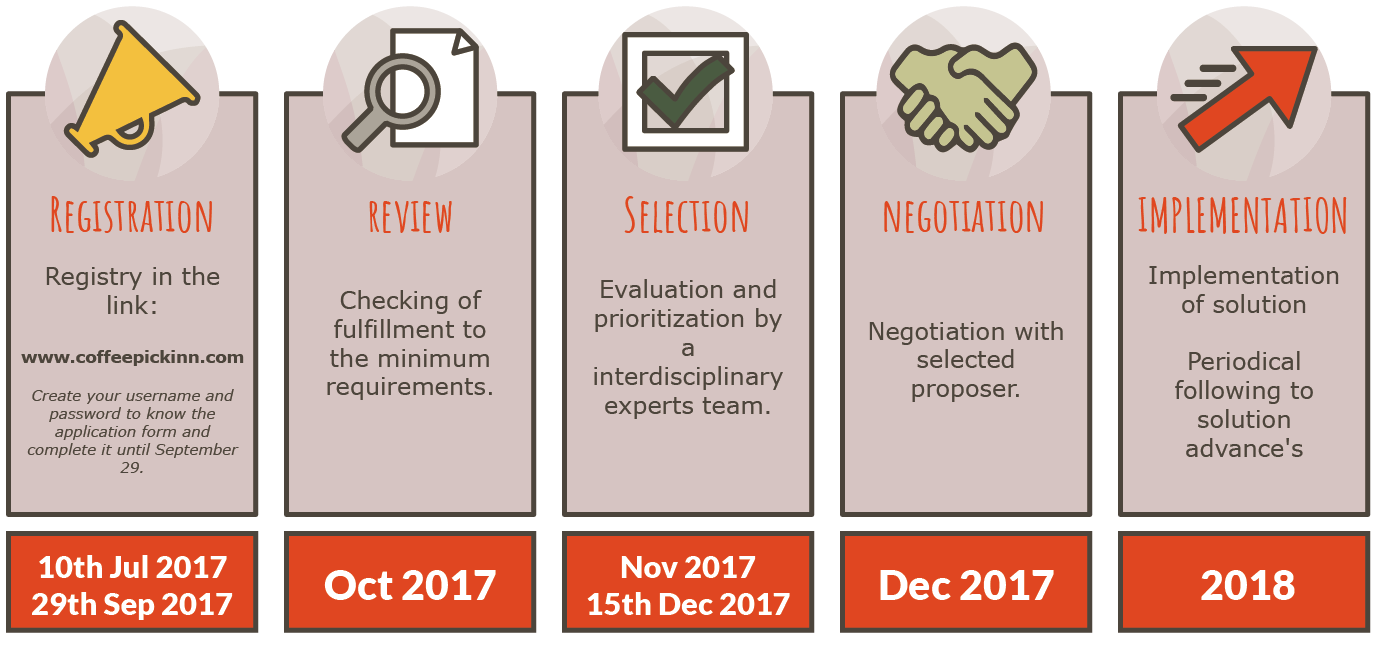
EVALUATION CRITERIA
 |
Progress of the solution | It evaluates the progress in the development of the solution and if it has been tested with positive results |
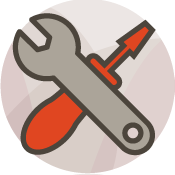 |
Technical and economic feasibility of implementation | It evaluates whether the proposed solution can be implemented both technically (this is adapted to the Colombian conditions) and financially (costs are borne by expected revenues) |
 |
Technical capacity of the executing team | It evaluates if the proposal has an interdisciplinary team with the knowledge and experience, that is able to develop and implement the solution |
 |
Innovation | It evaluates the degree of novelty in technical terms or in the business model to generate a significant impact on the Colombian coffee industry |
 |
Consistency with the challenge | It assesses how much the solution meets the challenge and whether the proposed solution is based on truthful and verifiable information |
 |
Scope of the solution | It evaluates if the solution addresses one or more of the four aspects of the challenge (technological, agronomic, economic, human and cultural) |
FAQ
1. How can apply?
Fulfillment of registry formulary in the link
2. Who can participate?
Can participate natural or juridcal persons over 18 years old, entrepreneurs, company and/or research groups, national o international with scientific or technological proposal that answer a innovative way to the challenge HOW TO MAKE COFFEE HARVESTING MORE EFFICIENT IN COLOMBIA?
3. May participate with several proposal?
The offersals can present several proposal, they should register a formulary for each one.
4. When is the deadline?
The announcement is open form july 10th to september 29th.
5. I Got a idea , but isn't is developed, can apply?
Within this program THE FEDERATION’s main objective is to find one or more proposals that will allow them to reach Colombian coffee growers to find solutions that are innovative, easy to take ownership of, acquire, and implement. Hence, THE FEDERATION’s main desire is to find and promote real and viable solutions to gain access to the Colombian market, so that the solutions can in turn become profitable and scalable businesses.
6. Who belongs the intellectual property?
THE FEDERATION will fully acknowledge and respect the intellectual property rights of the inventions developed by the proponents prior to their registration and candidature. By the same token, proponents and Users will fully acknowledge and respect THE FEDERATION’s intellectual property rights.
7. Which incentives exist for participate?
THE FEDERATION has a pool of resources in place - in cash or in kind – to be invested in the development and implementation in the Colombian countryside, for solutions that are most promising. This will be done through asset strengthening, or seed capital (risk or venture capital) if dealing with entrepreneurs, or by joint investment and partnerships or partnership agreements, if dealing with entrepreneurs or research centers.
LEGAL ISSUES
See terms of reference TERMS AND CONDITIONS OF THE OPEN INNOVATION PROGRAM – “COFFEEPICKINN CHALLENGE”
For more info please write us to: retocoffeepickinn@cafedecolombia.com.co
